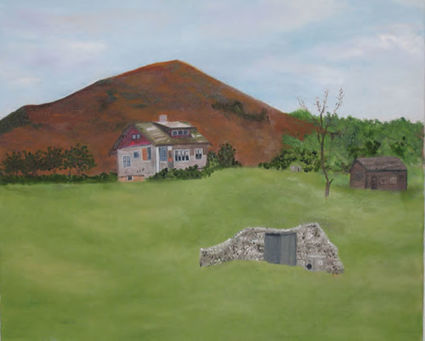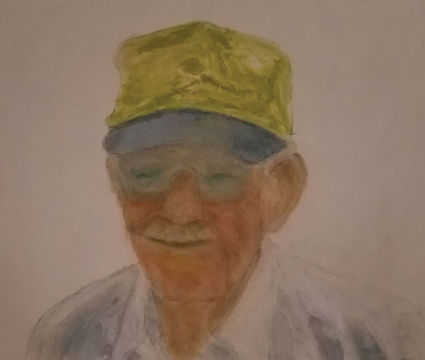END OF AN ERA
STEFFEN RANCH - PART 3
April 29, 2020
The previous article left the Steffen family at the gala, ground-breaking rodeo held on their property near Bloomfield, Montana in July, 1922, when Clarence was just short of 5 years old, and John was all of 6 months.
Our personal introduction to these brothers came in October, 2008. John had been recommended as someone important to Jane's project, and when contacted by telephone, he was cordial and invited us to visit him in Glendive, where he and his brother were living.
Having heard from others about his successful ranching and farming, complete with the added blessing of petroleum, we were prepared for something out of Better Homes and Gardens. The nondescript, neglected, tiny house we found at the address came as a considerable surprise, then, as did the figure of John Steffen himself, quite a small man, looking in every way as if belonging in such a place. The next surprise was that he didn't even own it.
No, the grand home his father, Fred, had built for his mother, Mollie (Margaret) had fallen into such disrepair as to become uninhabitable, so the brothers dwelled in this rented box to which fresh paint was no more than a memory. Inside, it was no more attractive and furnished sparsely in a style that highlighted low-end, second-hand stores.
John, nevertheless, was extremely articulate and introduced us to Clarence, evidently ill and infirm, supine in his bed just off the living room. A pint bottle on a window sill was his only sign of medication, and we attributed his wandering attention and glassy eyes to that over-the-counter elixir. As it occurred, however, the poor man, then 91, had few days of his allotted life remaining to him.
At the time of World War II, Clarence A. Steffen had been highly active. Entering the Army in 1942, he had been awarded the Combat Infantry Badge and the Bronze Star for his service in Italy. Following his discharge in 1945, he had returned to the family land near Bloomfield and farmed it until retiring.
It was to that same land that John proposed taking us that day, and, for another surprise, Clarence declared himself up to the tour, left his bed, and made it a party of four.
In the Record Tribune last week we mentioned features of the property and of the house Fred Steffen built, and "Ultra-Modern in 1915" is the painting of it that John commissioned. He was keenly interested in having it executed, even to specifying the size he wanted, but still frugal to the point of a little advance haggling over the price.
In the foreground are the remains of the concrete cow shed, the borrowed shack from his aunts' land is to the right, and to the viewer's right just back of the house lie the ruins of the smokehouse. Also visible in the scene, but omitted by John's choice on the grounds of its more recent addition, was an old trailer which once contained Clarence's lapidary equipment. He made jewelry from moss agates found in the vicinity and also amassed an enviable collection of arrowheads. All this already had been given away.
Alas! The once-magnificent house was also a ruin. Scattered over the ground floor were buckets and other rusting receptacles to catch water leaking down from the second story, where the bedrooms were and which we were not invited to see. Fine pieces of furniture sat in states of decay, stained, dirty, and molding, and the entire place was dusted with the inevitable rodent dung. The kitchen, fully furnished, had rat and mouse droppings in bowls, on plates and platters, even in the cooking pots that now collected dripping water. Withal, the sun still glittered through the cut glass of the ornate door. It reminded us not only of the happy years the house had helped supply to several lives, but also that goodness lies ahead for all of us creatures.
Throughout the tour the deep love the two men shared for their parents, their land, and for their Uncle Bill, who had once lived in a cave, was evident to us. At 86, John trotted like a colt up the painting's steep hill, where he had roamed as a child. On the very top, on land that had once belonged to their uncle, he showed us the very personal monument, a Jayhawk stacker, he and Clarence had created for him. John also mentioned that they unsuccessfully had tried to donate the ranch to the county as a park.
We were mightily impressed that Clarence had risen from a sickbed and possessed the resilience to enjoy the day's journey. For the most part he remained in the back seat and contributed little to the conversation, but his enjoyment showed in his eyes, and Jane snapped a photo of him in the truck.
Just days after this informative outing, John called to report his brother's death. Initially we felt guilty at having put him through an arduous day, but, with a little reflection, we concluded that, in anticipation of his passing, he had seen us as his final opportunity to enjoy the panorama over which so many years of his good and useful life had passed. John emphasized that it was his brother's work that had kept the ranch intact and asked for Jane's photo to include at the funeral.
Within weeks he called again to say he had moved to the Heritage on Merrill Assisted Living establishment in Glendive, and we drove there to see him. It was a lovely apartment, but he had learned to live without frills or furniture, which were as scarce as at the rental house: bed, small wooden table with three chairs – one comfortable and two around the table. It was there that we were treated to his father's photographic archive and learned fascinating details of John's career.
In the 1960s he had become convinced of the presence of oil on Steffen property and persuaded a number of friends to invest in the exploration. When it proved a failure, the investors accused him of misleading them, and John, not forgetful of their complaints, decided to absent himself from his critics.
In the way of distance, one might believe he overdid it, for he traveled about as far as possible, to Australia, and undertook a different sort of enterprise. Always a capable horseman and rodeo lover, he commenced raising and racing thoroughbreds and showed us photographs of his participating even as a jockey. He had boxes of souvenirs from this phase of his life and showed us such expected mementos as boomerangs and huge emu eggs.
The horse ventures succeeded so well, that when he returned, he was able to reimburse the disappointed investors every penny they had risked. On that point he was quite emphatic and patently proud.
On this occasion he mentioned that Clarence had willed his share of the property to the Catholic Diocese of Great Falls/Billings to be used for education. Though we are not acquainted with the details of their finances, we feel this bequest bore a value of perhaps millions of dollars. John's surmise regarding oil on their land had proven to be accurate, after all, and the advent of fracking technology made it accessible and added considerably to their worth.
Our next and final meeting with him came many weeks later, when he called from Billings Clinic Hospital, where he had been taken for treatment, and asked us to bring him Holy Communion. By that time the painting he had commissioned was complete. He approved it and asked that we give it to his sister, who lived in Billings.
He was also excited to relate how the Bishop had come to his Heritage apartment to greet him and bring him Communion. No less generous than his brother, John had willed his part of the estate to the Diocese for the support of the Catholic high school in Great Falls. If the education of the diocesan young people lags, it will not be the fault of these hard-working, altruistic brothers.
When, per Mr. Steffen's wishes, we delivered the painting to his sister, she asked rather crossly, "What am I supposed to do with that?" which suggests the opinion that the Diocese should have received it, and she, her brother's money. As someone once said, "You can't please some of the people any of the time," or something like that, but John Steffen always tried his best, and that is perhaps the finest epitaph anyone can earn.
He was not the bragging sort of fellow, so it did not surprise us that he neglected to mention that in 2003 he and Clarence had been honored as Conservation Farmer and Rancher of the Year by the Dawson County Conservation District. The award serves as additional proof of the way the two men thought of their land and managed it.
This is a tribute John wrote to all the homesteaders of his father's and uncle's era, and it is a mirror for his morals and standards.
"We, the sons and daughters of the homesteaders, owe you a debt of gratitude. You suffered and sacrificed much for us. You have given us a less rigorous, more enriching and rewarding life than you endured. You gave us a heritage surpassing monetary worth. You gave us a sense and appreciation of values, a love of country, family, and neighbor. In the western ranching and homestead areas of today, this heritage is reflected in our present-day youth who show a greater sense of balance than their counterparts in other areas of America."









Reader Comments(0)